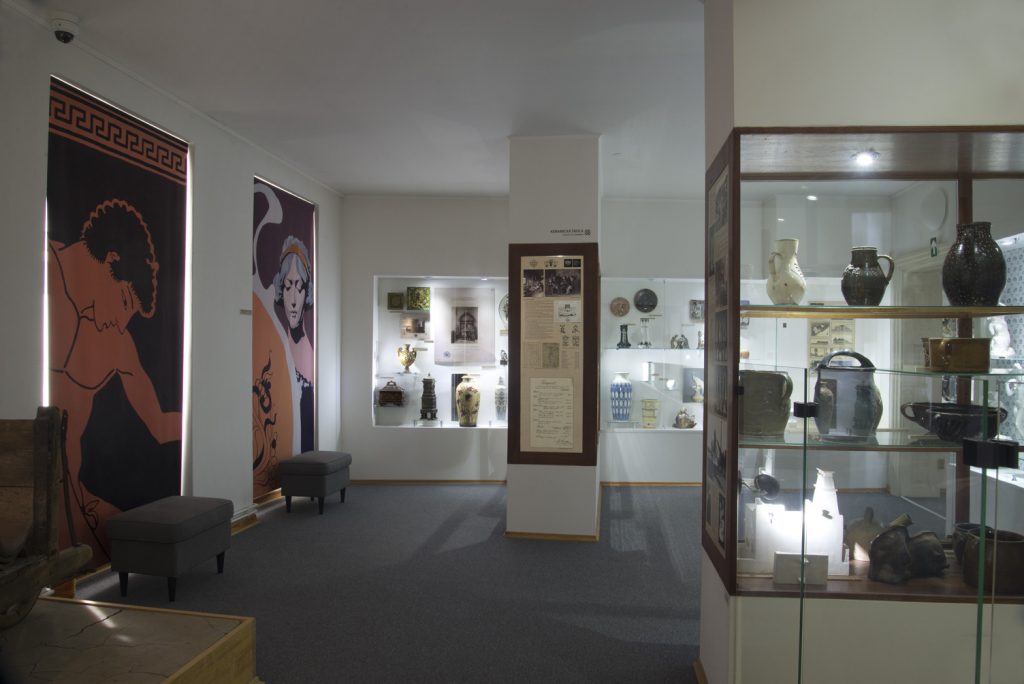About the museum
In 1911, professors of the local vocational school founded the Ceramic Museum Association. The several rooms in the town hall at that time were not enough for the ever-expanding collections. Since 1938, the museum has been located in two burgher houses on the square. After an extensive reconstruction, the museum was reopened in 2007. The museum won the Gloria Musaealis Award in 2014 for the installation of a permanent exhibition. In addition to the permanent exhibition, you can visit temporary exhibitions and cultural programs such as Advent markets, museum night, etc.
Permanent displays
“The permanent exhibition consists of three sections: The largest section is dedicated to the History of the City of Bechyně and its surroundings from prehistoric times to the present. On the ground floor, you can see a selection of ceramic works from the collection of the local vocational school of ceramics from the years 1884–1950. The third section, located in the hall, highlights the production of the manufacturer known as the Production of Ceramics Cooperative Bechyně and Keras from the years 1903–1950.”
The exhibition History of the City of Bechyně is dedicated to the history of the town of Bechyně and its surroundings from prehistory to the present. Among other things, the visitor will see archaeological finds from the Bechyně region from the Stone Age to the Middle Ages, as well as a section dedicated to Bechyně as a place of pilgrimage. It presents the Franciscan monastery built on a cliff above the river Lužnice, which is known for its diamond vaulting and was once the center of Marian piety. At one time, it was the most-visited pilgrimage place in southern Bohemia. In other rooms, you can see photo documentation of the construction of the local reinforced concrete bridge (1926–1928), a unique technical landmark that was included in the list of national cultural monuments in 2014. There is also a reminder of the important inventor František Křižík and his successful completion of the electrified railway, Tábor – Bechyně, called “Elinky,” which was put into operation in 1903. A recreation of the room known in Czech as Selská jizba offers a view of the main living area of a country house at the end of the 19th century. It includes examples of the national dress from the Kozácko district typical of the Tábor region. A significant part of the exhibition reminds us of the production of local ceramic workshops and manufacturers, the origin and development of a professional ceramic school, and the tiled stove tradition. The last room captures the changes in Bechyně in the 20th century, including the development of the city in the areas of culture, sports, and industry.








Opening time
| MAY, OCTOBER | ||
| PO | 9.00–12.00 | 12.30–17.00 |
| ÚT | 9.00–12.00 | 12.30–17.00 |
| ST | 9.00–12.00 | 12.30–17.00 |
| ČT | 9.00–12.00 | 12.30–17.00 |
| PÁ | 9.00–12.00 | 12.30–17.00 |
| SO | 12.30–17.00 | |
| NE | CLOSED | |
| JUNE – SEPTEMBER | ||
| PO | 9.00–12.00 | 12.30–17.00 |
| ÚT | 9.00–12.00 | 12.30–17.00 |
| ST | 9.00–12.00 | 12.30–17.00 |
| ČT | 9.00–12.00 | 12.30–17.00 |
| PÁ | 9.00–12.00 | 12.30–17.00 |
| SO | 9.00–12.00 | 12.30–17.00 |
| NE | 9.00–12.00 | 12.30–17.00 |
| NOVEMBER – APRIL | ||
| PO | 8.00-12.00 | 12.30-17.00 |
| ÚT | 8.00–12.00 | 12.30–16.00 |
| ST | 8.00–12.00 | 12.30–17.00 |
| ČT | 8.00–12.00 | 12.30–16.00 |
| PÁ | 8.00–12.00 | 12.30–16.00 |
| SO | CLOSED | |
| NE | CLOSED |
Admission
Basic 60 CZK
Reduced (children 6–15 years, students, seniors) 40 CZK
Disabled individuals and children less than 6 years old – free admission
Family entry 160 CZK
Contact
Městské muzeum Bechyně, nám. T. G. M. 140
muzeum@kulturnidum.cz, phone No: +420 774 911 067